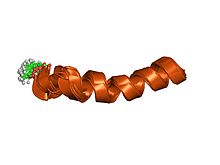Vpr
| VPR | |||||||||
|---|---|---|---|---|---|---|---|---|---|
 solution structure of hiv-1 vpr (13-33) peptide in micells | |||||||||
| Identifiers | |||||||||
| Symbol | VPR | ||||||||
| Pfam | PF00522 | ||||||||
| InterPro | IPR000012 | ||||||||
| SCOP2 | 1dsk / SCOPe / SUPFAM | ||||||||
| TCDB | 1.A.42 | ||||||||
| |||||||||
Vpr is a Human immunodeficieny viral gene and protein product.[1][2]
Vpr stands for "Viral Protein R". Vpr, a 96 amino acid 14-kDa protein, plays an important role in regulating nuclear import of the HIV-1 pre-integration complex, and is required for virus replication in non-dividing cells such as macrophages. Vpr also induces G2 cell cycle arrest and apoptosis in proliferating cells, which can result in immune dysfunction.[3][4]
Vpr is also immunosuppressive due to its ability to sequester a proinflammatory transcriptional activator in the cytoplasm. HIV-2 contains both a Vpr protein and a related (by sequence homology) Vpx protein (Viral Protein X). Two functions of Vpr in HIV-1 are split between Vpr and Vpx in HIV-2, with the HIV-2 Vpr protein inducing cell cycle arrest and the Vpx protein required for nuclear import.
Protein
VprBP is a 1,507-amino-acid protein that contains conserved domains, including YXXY repeats, the Lis homology motif, and WD40 repeats.[5]
Function
Vpr binding protein (VprBP) regulates the p53-VprBP interaction with HIV-1 viral protein R. VprBP regulates p53-induced transcription and apoptotic pathways. p53 is an important tumor suppressor which induces either cell cycle arrest or apoptosis in response to DNA damage. This fits in with the fact that HIV attacks CD4+ cells.[5]
References
- ^ Vpr+Gene+Products,+Human+Immunodeficiency+Virus at the U.S. National Library of Medicine Medical Subject Headings (MeSH)
- ^ Genes,+Vpr at the U.S. National Library of Medicine Medical Subject Headings (MeSH)
- ^ Bukrinsky M, Adzhubei A (1999). "Viral protein R of HIV-1". Rev. Med. Virol. 9 (1): 39–49. doi:10.1002/(SICI)1099-1654(199901/03)9:1<39::AID-RMV235>3.0.CO;2-3. PMID 10371671.
- ^ Muthumani K, Choo AY, Zong WX; et al. (February 2006). "The HIV-1 Vpr and glucocorticoid receptor complex is a gain-of-function interaction that prevents the nuclear localization of PARP-1". Nat. Cell Biol. 8 (2): 170–9. doi:10.1038/ncb1352. PMID 16429131.
{{cite journal}}: Explicit use of et al. in:|author=(help)CS1 maint: multiple names: authors list (link) - ^ a b Kim K, Heo K, Choi J, Jackson S, Kim H, Xiong Y; et al. (2012). "Vpr-binding protein antagonizes p53-mediated transcription via direct interaction with H3 tail". Mol Cell Biol. 32 (4): 783–96. doi:10.1128/MCB.06037-11. PMC 3272969. PMID 22184063.
{{cite journal}}: Explicit use of et al. in:|author=(help)CS1 maint: multiple names: authors list (link)
